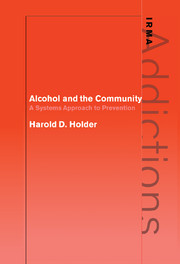Book contents
- Frontmatter
- Contents
- Series editor's preface
- Acknowledgements
- 1 The community system of alcohol use and alcohol problems
- 2 Consumption System
- 3 Retail Sales Subsystem: alcohol availability and promotion
- 4 Formal Regulation and Control Subsystem: rules, administration, and enforcement
- 5 Social Norms Subsystem: community values and social influences that affect drinking
- 6 Legal Sanctions Subsystem: prohibited uses of alcohol
- 7 Social, Economic, and Health Consequences Subsystem:community identification of and responses to alcohol problems
- 8 Community-level alcohol problem prevention
- References
- Index
8 - Community-level alcohol problem prevention
Published online by Cambridge University Press: 22 September 2009
- Frontmatter
- Contents
- Series editor's preface
- Acknowledgements
- 1 The community system of alcohol use and alcohol problems
- 2 Consumption System
- 3 Retail Sales Subsystem: alcohol availability and promotion
- 4 Formal Regulation and Control Subsystem: rules, administration, and enforcement
- 5 Social Norms Subsystem: community values and social influences that affect drinking
- 6 Legal Sanctions Subsystem: prohibited uses of alcohol
- 7 Social, Economic, and Health Consequences Subsystem:community identification of and responses to alcohol problems
- 8 Community-level alcohol problem prevention
- References
- Index
Summary
Introduction
The goal of prevention is to reduce the future occurrence of alcoholinvolved problems, which (as defined in this book) are the natural products (output) of the community system. How to develop effective long-term interventions or changes in this complex, open, and adaptive system is neither simple nor obvious. As an adaptive system, the community will not be affected by prevention programs or efforts that make no changes in the system's structure or processes. Furthermore, the system will adjust to and compensate for prevention efforts that do alter its natural arrangements. Such community system adjustments hamper the potential long-term effectiveness of any prevention intervention and are the most serious obstacle to cost-effective alcohol problem prevention in the long term.
For example, consider what happens in the community if enforcement against drinking and driving is increased, and, as a result of publicity about increased enforcement, drivers believe their chance of being detected and arrested for driving under the influence (DUI) is now much higher (i.e., perceived risk of arrest increases). If the actual risk of arrest has increased only slightly (so that it is much lower than the new perceived risk), then, over time, drivers will learn that their perceived risk is much too high. As a result, they will naturally return to their prior drinking and driving behavior, and little or no long-term reduction in alcohol-involved crashes will result. Similarly, consider the effects of increasing the retail prices of alcoholic beverages, say by 10%.
- Type
- Chapter
- Information
- Alcohol and the CommunityA Systems Approach to Prevention, pp. 134 - 157Publisher: Cambridge University PressPrint publication year: 1998



